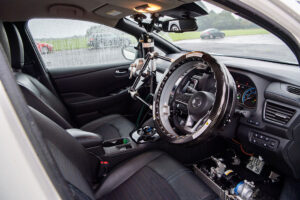XR in the utilities sector has undeniable advantages: lower service costs, improved maintenance process, more effective remote maintenance, greater security for employees. AR will generate $ 18 billion in global energy and utility sales. What is this money used for?

“I love augmented reality because unlike virtual reality, which locks the world in place, AR enables individuals to be present in the world, but hopefully an improvement on what’s going on.”
Tim Cook, Apple CEO
Today’s utilities and energy sectors are facing a massive wave of strong disruptions due to advances in IT technologies. The increasing demand for electricity in the rapidly developing countries and the increasing cost pressure are causing this industry to rethink the traditional business models it uses. Augmented and virtual realities are on the way to innovate and transform this sector. According to ABI Research, global market revenue for the energy and utilities sectors will total $ 18 billion by 2022. What is this money used for? I will give the answer to this question later. The important things first.
What’s the difference between AR and VR?
One of the most innovative technologies that are responsible for the current technical failures is Virtual Reality (VR). By simulating an alternative reality, VR technology enables the user to immerse themselves in an artificially created environment and enables them to interact with the virtual world. VR applications typically require specific devices, such as a head mounted display (HMD) and haptic controllers, that allow the user to experience the imaginary world and manipulate virtual objects.

Augmented Reality (AR) refers to a real environment, which is supplemented by various digital objects such as sounds, videos and graphics that extend over the physical environment. In contrast to VR headsets, AR devices do not block the view of the real environment like VR helmets. AR is mainly used in smartphones and smart glasses and does not require any additional equipment such as helmets.
Essentially, the main difference between AR and VR is that AR complements reality with software embedded in different devices. While VR devices offer an artificially created environment, AR devices complement reality and enable the user to manipulate, move and perform operational processes without obstacles that exist in real work.
What challenges can AR / VR solve in the utilities sector?
The energy and utilities industry faces a number of challenges today that arise from an outdated infrastructure, the rising retirement pension of highly qualified workers, the modernization of the networks and government regulations. All of this puts great pressure on utilities that want to remain competitive in the market.
There are 2 major issues that are related:
The biggest problem in the utilities sector is the aging of the workforce, which leads to the loss of institutional knowledge. According to a report by the U.S. Department of Energy, 25% of U.S. employees in electricity and natural gas utilities will retire in the next five years. Therefore, companies are forced to fill vacancies with newcomers whose expertise and experience are limited. In addition, utilities struggle to find high quality workers. According to a U.S. survey Department of Energy 72 percent of energy employers complain about the lack of qualified personnel.
Aging power generation and distribution systems is another major challenge for the utilities sector. Harris Williams & Co. estimated that almost 70% of the transformers are over 25 years old, while 60% of the distribution booms are 30 to 50 years old. Under the current circumstances, energy and utility companies are forced to expand their networks in order to be able to offer their customers reliable and inexpensive products.
Now let’s see how AR technology can help the utilities meet these challenges.
AR applications for energy and utilities

- Accelerated process of plant maintenance. One of the most promising AR applications is plant maintenance. AR technology can force a 3D model on a device in real time, so a number of problems can be solved faster and more efficiently. Field service technicians who are equipped with mobile AR devices or smart glasses have immediate access to the operating documentation and can thus view the system type, the maintenance history or the exchange conditions. In the event of equipment damage, a line judge can respond immediately by ordering a replacement or consulting a technician to resolve the problem. The introduction of AR applications in the energy and utilities industry significantly speeds up operational processes, reduces costs and saves time.
- Effective remote support. AR has also found its use in remote consulting. The technology enables business experts to lead inexperienced sales representatives in real time, thereby significantly reducing the costs for technical experts (SMEs). If necessary, SMEs can use AR equipment to guide young workers and give them eyes, ears and hands on the ground. This application enables employers to keep very experienced retired or aging employees in the workforce by giving them the opportunity to work remotely.

- Faster training for skilled workers. One of the greatest opportunities that VR / MR offers is employee training. Today, every effective company needs to train its own employees to increase the efficiency of service delivery for customers. AR improves learning processes by inserting virtual objects such as images and videos into the environment. In this way, the employees of the utilities can optimally use everything they need in their field of vision and thus get a better understanding of the devices and operational processes. AR can support energy and utility companies to significantly improve their training programs and prepare the highly skilled workforce.
- Higher operational security AR helps improve operational security. With AR devices, employees are able to model underground facilities and heavy equipment to predict potential problems. By using connected AR glasses that field technicians wear at work, the dangers of damaged devices can be identified and eliminated. By using AR technology, the implementation of safety protocols can be visualized in real time on the ground, which improves productivity and occupational safety.
How can AR energy and utility companies benefit from this?
- Service expenses decrease. The use of XR technologies gives companies the opportunity to hire experienced employees and train them through AR training programs. Additionally, with the XR solution, companies can avoid going through a complex diagnostic process of troubleshooting devices that focuses on resolving identified AR problems. Another area where AR can bring significant savings is the decrease in the number of engineers.
- Less service time. AR offers real-time availability of complex engineering knowledge and the support of senior engineers, which significantly reduces travel costs and optimizes the time required to complete a task. In addition, the AR solution reduces the time it takes to perform field tasks because employees can easily access the information and statistics they need.
- Lower accident risk. Through the use of XR technology, a company can identify systematic errors and thus reduce the probability of errors. Regular and more efficient monitoring of the devices helps to increase safety in the workplace.
- Less training costs. The XR approach to employee training is cheaper and more practical than traditional training models because virtual training does not require expensive equipment.
- Shorter training time. XR training is less time consuming than traditional training. In addition, the trainees can go through the training material at their own pace, which makes their learning more efficient. In addition, an energy and utility company with XR technology can offer distance learning taught by leading coaches from around the world. XR-embedded technologies come into the energy and supply industry and provide more security and efficiency. Investing in AR helps utilities meet a number of challenges to make the business more effective and competitive. AR is no longer a futuristic concept, but a reality. Its implementation in the energy and utilities sector opens up new opportunities for the development of this industry.

info@staff-eye.com




